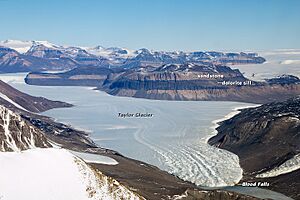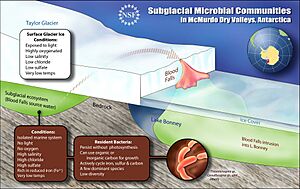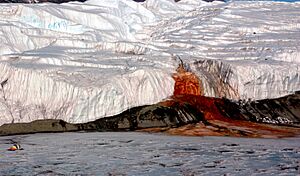Blood Falls facts for kids

Blood Falls is an amazing natural wonder in Antarctica. It's a stream of very salty water that looks like blood, flowing from the Taylor Glacier onto West Lake Bonney. This happens in the Taylor Valley, part of the McMurdo Dry Valleys in Victoria Land, East Antarctica.
The water is bright red because it's full of tiny bits of iron(III) oxide, which is like rust. This super salty, iron-rich water sometimes pushes out from small cracks in the ice. The source of this water is a hidden pool deep under about 400 meters (1,300 feet) of ice, several kilometers away from where it comes out.
An Australian geologist named Thomas Griffith Taylor first discovered this reddish deposit in 1911. He was exploring the valley that now carries his name. At first, people thought the red color came from red algae. But later, scientists proved it was actually due to iron turning rusty when it met the air.
Contents
What Makes Blood Falls Red?
Why is it Red?
The striking red color of Blood Falls comes from a chemical reaction. When the iron-rich water, which has been trapped away from air for a very long time, finally meets the oxygen in the atmosphere, the iron in it rusts. This rusting process creates hydrous ferric oxides, which are tiny, reddish-brown particles that give the water its unique "blood" color.
Where Does the Salty Water Come From?
The super salty water comes from an ancient pocket of seawater. Millions of years ago, during a time called the Miocene period, the sea level was higher. A fjord (a long, narrow inlet of the sea) was cut off by the advancing Taylor Glacier. This trapped a large amount of seawater underneath the ice.
Over a very long time, as the glacier grew and cooled the trapped water, pure ice crystals formed. These crystals pushed out the salt, making the remaining water incredibly salty, much saltier than today's ocean water. This very salty water doesn't freeze easily, even at extremely cold temperatures, which is why it can still flow out of the glacier.
Tiny Life in Extreme Cold

How Do These Microbes Survive?
Scientists have found a very special and rare ecosystem of tiny living things, called bacteria, deep within the salty water under the glacier. These bacteria are unique because they don't need sunlight or even much oxygen to survive. Instead, they get their energy by using chemicals like sulfate and iron. This way of life, where organisms create their own food from chemicals, is called autotrophic.
According to geomicrobiologist Jill Mikucki from the University of Tennessee, samples from Blood Falls contained at least 17 different kinds of microbes. They live in water with almost no oxygen. These microbes use sulfate to "breathe" and react with iron, helping them to process the tiny amounts of organic matter trapped with them. This kind of chemical process was a new discovery for scientists!
Exploring the Glacier's Secrets
In December 2014, scientists and engineers, led by Jill Mikucki, went back to Taylor Glacier. They used a special probe called IceMole. This probe was designed to melt its way into the glacier and directly collect samples of the salty water that feeds Blood Falls.
The samples showed that the water was very cold (about -7 degrees Celsius or 19 degrees Fahrenheit), very salty (about 8% sodium chloride), and rich in iron. From these samples, scientists found a type of bacteria that loves salty water (called halophilic) and thrives in the cold (called psychrophile). They named this bacteria Marinobacter. By studying its DNA, they learned that it has special genes that help it produce protective chemicals, like antioxidants, and even pigments that might give it color. Other bacteria like Thiomicrospira sp. and Desulfocapsa sp. were also identified.
Lessons from Blood Falls
A Look Back at "Snowball Earth"
Scientists believe the hidden pool of water under Blood Falls has been sealed off for about 1.5 to 2 million years. It's like a "time capsule" that has kept these ancient microbes isolated. This discovery helps explain how other tiny organisms might have survived when Earth, according to the "Snowball Earth" idea, was almost completely covered in ice millions of years ago.
During those times, oceans covered by thick ice might have been the only safe places for microbial life to continue. This happened about 650 to 750 million years ago, during the Proterozoic eon.
Searching for Life Beyond Earth
Blood Falls offers scientists a unique chance to study life in extreme conditions deep underground without needing to drill deep holes. This is important because drilling can sometimes accidentally contaminate a delicate environment.
Studying harsh places on Earth helps us understand how life can adapt. This knowledge is very useful for thinking about the possibility of life elsewhere in our Solar System. For example, scientists from the NASA Astrobiology Institute wonder if planets like Mars or moons like Europa (which orbits Jupiter) could have hidden liquid water under their icy surfaces. Life in such places would be protected from harmful ultraviolet and cosmic radiation that hits the surface.
See also
- Extremophiles (organisms resistant to extreme conditions)
- Psychrophile (bacteria resistant to cold)
- Cryoconcentration of hypersaline brines
- Eutectic system
- Freezing-point depression
- Life on Mars
- Thiomicrorhabdus arctica


